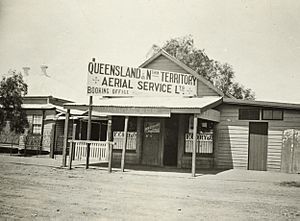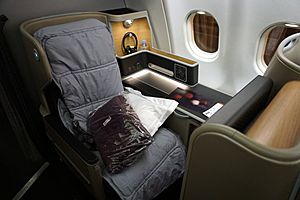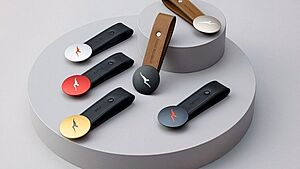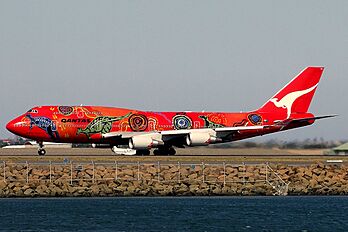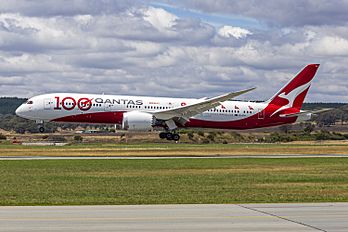Qantas facts for kids

A Qantas Boeing 787-9
|
|
| Founded | 16 November 1920 Winton, Queensland, Australia |
|---|---|
| Commenced operations | 2 November 1922 |
| AOC # | CASA.AOC.0001 |
| Hubs | |
| Focus cities | |
| Frequent-flyer program | Qantas Frequent Flyer |
| Alliance | Oneworld |
| Subsidiaries |
Qantas Loyalty
Qantas Frequent Flyer
Qantas Business Rewards Qantas Hotels Qantas Holidays Qantas Shopping Qantas Wine Qantas Money Qantas Insurance Qantas Wellbeing |
| Fleet size | 125 |
| Destinations | 104 |
| Parent company | Qantas Airways Limited |
| Headquarters | Mascot, New South Wales, Australia |
| Key people | |
| Revenue | |
| Operating income | |
| Total assets | |
| Total equity | |
| Employees | |
Qantas is Australia's main airline. It is the largest airline in Australia and Oceania based on its number of planes, international flights, and destinations. Qantas was one of the first airlines to join the Oneworld airline group. It is also the only airline that flies to all seven continents. This includes flights to Africa, Antarctica, Asia, Europe, North America, and South America. Its main bases are in Sydney, Perth, Melbourne, and Brisbane. Qantas also flies to over 60 places within Australia.
Qantas is one of the oldest airlines still flying today. It started in November 1920. The name Qantas is short for Queensland and Northern Territory Aerial Services. This was because it first served areas in Queensland and the Northern Territory. Over the years, the company has changed a lot. It was once owned by the government and then became a private company. People often call it "The Flying Kangaroo." Its official motto is "Spirit of Australia."
Qantas is based in Mascot, a suburb of Sydney. This is right next to its main hub at Sydney Airport. As of March 2023, Qantas Group carried 60.8% of all passengers on Australian domestic flights. Other smaller airlines owned by Qantas, like QantasLink, fly to smaller towns and some shorter international routes. Qantas also owns Jetstar, which is a low-cost airline. Jetstar flies both internationally from Australia and within Australia and New Zealand. Qantas also has shares in other Jetstar airlines in Asia, as well as Alliance Airlines and Fiji Airways.
Contents
The History of Qantas


How Qantas Started
Qantas was started in Winton, Queensland on November 16, 1920. The founders were Hudson Fysh, Paul McGinness, and Fergus McMaster. They named it Queensland and Northern Territory Aerial Services Limited (QANTAS). Their first plane was an Avro 504K. The company's main office moved to Longreach, Queensland in 1921 and then to Brisbane in 1930.
The QEA Years
In 1934, QANTAS teamed up with Britain's Imperial Airways. This company was an early version of British Airways. They formed a new company called Qantas Empire Airways Limited (QEA). In December 1934, the new airline began flying between Brisbane and Darwin. QEA started international flights in May 1935. The service from Darwin was extended to Singapore. Imperial Airways then flew passengers the rest of the way to London. During World War II, half of their ten planes were lost due to enemy attacks and accidents. The Australian government took over most of the remaining planes for war use.
In 1943, flying boat services started again. These flights went between the Swan River in Perth, Western Australia, and Koggala Lake in Ceylon (now Sri Lanka). This connected with flights from British Overseas Airways Corporation (BOAC) to London. BOAC was the airline that took over from Imperial Airways. Qantas first used its kangaroo logo on the "Kangaroo Route" in 1944. This route went from Sydney to Karachi, where BOAC crews took over for the rest of the trip to the UK.
In 1947, the Australian government, led by Prime Minister Ben Chifley, took over QEA. QANTAS Limited was then closed down. After this, Qantas' flights within Queensland were given to Trans-Australia Airlines, which was also government-owned. This left Qantas with only international flights. Soon after, QEA began flying outside the British Empire, with services to Tokyo and Hong Kong. In 1957, a new main office, Qantas House, opened in Sydney.
The Jet Age and Beyond
In June 1959, Qantas started using jet planes when it received its first Boeing 707–138. The company we know today, Qantas Airways Limited, was officially formed in 1967. On September 14, 1992, Qantas joined with another Australian airline, Australian Airlines. Australian Airlines had been called Trans-Australia Airlines before 1986. In 1993, Australian Airlines' planes started to be painted with Qantas colors. Qantas slowly became a private company between 1993 and 1997.
Oneworld Alliance and Jetstar
In 1998, Qantas helped start the Oneworld alliance. Other founding airlines included American Airlines, British Airways, Canadian Airlines, and Cathay Pacific. More airlines joined later.
In 2000, a new discount airline called Virgin Blue (now Virgin Australia) started flying in Australia. This caused Qantas' share of the market to drop. To compete, Qantas created the budget airline Jetstar in 2001. The main competitor to Qantas, Ansett Australia, stopped flying in September 2001.
Qantas briefly brought back the Australian Airlines name for a short-lived international budget airline from 2002 to 2006. This airline was closed down to focus on making Jetstar bigger internationally, including flights to New Zealand. In 2004, the Qantas group also entered the Asian budget airline market with Jetstar Asia. Qantas owns a part of this airline. In 2007, a similar plan was used for an investment in Jetstar Pacific in Vietnam, and Jetstar Japan, which started in 2012.
In December 2006, a group called Airline Partners Australia tried to buy Qantas, but the deal failed. In 2008, talks about merging with British Airways also did not lead to an agreement. In 2011, a disagreement between Qantas and the Transport Workers Union of Australia caused all Qantas planes to be stopped and staff to be locked out for two days.
On March 25, 2018, a Qantas Boeing 787 flew non-stop between Australia and Europe for the first time. Flight 9 (QF9) arrived in London after a 17-hour journey. It covered 14,498 kilometers (9,009 miles) from Perth Airport in Western Australia to London Heathrow.
On October 20, 2019, Qantas Airways completed its longest commercial flight at that time. A Boeing 787–9 Dreamliner flew from New York City to Sydney in 19 hours and 20 minutes.
The COVID-19 Pandemic and Recovery
On March 19, 2020, Qantas stopped about 60% of its domestic flights. It also put two-thirds of its employees on leave and stopped all international flights from the end of March until at least May 31, 2020. This was due to government travel rules during the COVID-19 pandemic. To survive, Qantas cut 6,000 jobs and planned to raise A$1.9 billion in new money. Qantas also sold its 30% share in Jetstar Pacific to Vietnam Airlines, ending the Jetstar brand in Vietnam.
In July 2020, Qantas stopped using its last Boeing 747-438ER. This plane type had been flying for almost 49 years since August 1971. All twelve Airbus A380s were put into storage for at least three years. Ten went to Mojave Air & Space Port and two to Los Angeles International Airport. The pilots of the last Boeing 747 flight drew the shape of the Qantas logo in the sky before landing.
In November 2020, Qantas said that passengers flying overseas would need to show proof of COVID-19 vaccination. The airline's CEO, Alan Joyce, stated that a vaccine would be necessary for international travel. Qantas also announced another cut of 2,000 jobs to reduce financial losses.
In August 2021, Qantas required all 22,000 of its employees to be fully vaccinated against the virus.
In May 2022, Qantas ordered twelve A350-1000 planes from Airbus. These planes are planned for non-stop flights from Sydney to London starting in late 2025. In the same month, Qantas agreed to buy Alliance Airlines. However, in April 2023, the Australian Competition & Consumer Commission (ACCC) did not approve the takeover.
By April 2024, Qantas had brought ten of its original twelve A380s back into service. All these planes had been updated to improve their interiors.
Non-stop Flight Routes
In August 2022, Qantas Airways announced plans to compete with Air New Zealand on the non-stop Auckland–New York route starting in June 2023. Qantas flights would start in Sydney. As part of "Project Sunrise," Qantas plans to fly non-stop from Sydney to New York starting in 2025. Qantas wants to make long distances feel shorter by creating non-stop flights connecting Australian cities to New York City and London. In February 2023, Qantas announced large profits of A$1.7 billion for the second half of 2022, after losing money during COVID. On November 3, 2023, nearly 83% of Qantas shareholders voted against the airline's pay report. This was described by ABC News as a "mammoth protest vote."
Where Qantas Flies
Destinations and Routes
Qantas flies regularly from Australia to places in Africa, Asia, Europe, North America, and South America. Its flights within Australia serve all Australian states, the Australian Capital Territory, the Northern Territory, and Norfolk Island. Qantas also offers special "flightseeing" trips to Antarctica from Sydney, Melbourne, Brisbane, and Perth. These flights used to depart from Adelaide, Canberra, and Hobart too. Qantas started these Antarctic flights in 1977. They were stopped for some years after the crash of Air New Zealand Flight 901 on Mount Erebus in 1979. Qantas restarted the flights in 1994. Even though these flights do not land, they need special training for flying in polar areas. This is because of things like sector whiteout, which was a factor in the 1979 Air New Zealand disaster.
Special International Domestic Routes
Qantas uses Perth as a stop for its flights to Europe, like those between Sydney and Paris (QF33 and QF34). It also uses Perth for a seasonal service between Sydney and Rome (QF5 and QF6). These flights arrive and depart from the international terminal at Sydney Airport, even though the Sydney-Perth part of the flight is domestic. Since Qantas is an Australian airline, it can carry passengers who only want to fly between Sydney and Perth. Qantas gives these domestic passengers an orange 'D' sticker. This allows them to skip customs and immigration, and they do not need passports.
As of June 2025, Qantas has agreements to share flights with many other airlines. This means you might book a Qantas flight, but part of your journey could be on a partner airline's plane.
- Air France
- Air New Zealand
- Air Tahiti Nui
- Aircalin
- Airlink
- Airnorth
- Alaska Airlines
- American Airlines
- Bangkok Airways
- British Airways
- Cathay Pacific
- China Airlines
- China Eastern Airlines
- China Southern Airlines
- El Al
- Emirates
- Fiji Airways
- Finnair
- Hawaiian Airlines
- IndiGo
- Japan Airlines
- Jetstar
- Jetstar Asia (ends July 31, 2025)
- Jetstar Japan
- KLM
- LATAM Chile
- Oman Air
- Skytrans (begins February 26, 2026)
- SriLankan Airlines
- WestJet
Qantas Aircraft Fleet
Current Aircraft
As of November 2024, the Qantas Group and its smaller airlines fly 308 planes. This includes 85 planes for Jetstar Airways, 90 for the different QantasLink airlines, and eight for Express Freighters Australia (which flies for Qantas Freight).
The group also has orders for over 150 smaller planes and 36 larger planes as of August 2024. These new planes are from the Airbus A220, Airbus A320neo, Airbus A321neo, Airbus A350, and Boeing 787 families. They will replace older planes over the next ten years and will be used by Qantas, QantasLink, and Jetstar.
Inside the Qantas Plane
International Flights
First Class

First class is available on the Airbus A380 and A350 planes. It has 14 private suites. The seats face forward for takeoff but can turn sideways for sleeping or eating. They can become a fully flat bed that is 212 cm (83.5 inches) long and 74 cm (29 inches) wide. Each suite has a 43 cm (17 inch) widescreen TV. There are also power outlets and USB ports. Passengers can use a lounge area on the upper deck. They also get free access to first class and business class lounges at airports.
These seats were updated on the refurbished Airbus A380 planes starting in late 2019. The new seats have better cushions and bigger entertainment screens.
Business Class
Business Suites
Business Suites are found on all Boeing 787, Airbus A330, and some Airbus A380 planes. These seats can lie flat and are arranged so that every passenger has direct aisle access. The Business Suite was first used on the A330 in October 2014. It includes a Panasonic touchscreen entertainment system. By the end of 2016, all of Qantas' Airbus A330 planes had these new business class seats. Airbus A330 Business Suites are used on flights to Asia, cross-Australia flights, and some flights to New Zealand.
Newer versions of this seat were put into the new Boeing 787 planes starting in late 2017.
Premium Economy
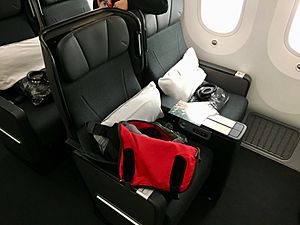
Premium economy class is offered on all Airbus A380 and Boeing 787–9 planes. On the Airbus A380, the seats have a space of 97 to 107 cm (38 to 42 inches) and are 49.5 cm (19.5 inches) wide. On the Boeing 787, seats are arranged in rows of 2-3-2. On the A380, they are also 2-3-2 at the back of the upper deck. The number of seats changes depending on the plane type. A380s have 35–60 seats, and 787s have 28 seats.
In 2019, Qantas started updating its Airbus A380 planes with the same new Premium Economy seats found on Boeing 787 planes. The new cabin will have 25 more premium economy seats than before.
Economy Class
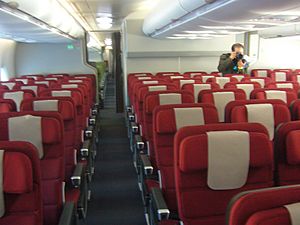
International Economy class is available on all Qantas passenger planes. Seats usually have a space of 79 cm (31 inches) and are 43 to 44.5 cm (17 to 17.5 inches) wide. The seating layouts are 3–3 on the 737, 2-4-2 on the A330, and 3-3-3 on the B787-9. On the A380, the layout is 3-4-3. There are also four self-service snack bars between the cabins.
In 2019, Qantas began updating its Airbus A380 planes with new Economy seats. These seats have new cushions and better entertainment systems, like those on Airbus A330 and Boeing 787 planes. The updated planes will have fewer economy seats because there are more premium seats.
In-flight Entertainment
All Qantas planes have some kind of video and audio entertainment. Qantas uses several types of in-flight entertainment (IFE) systems.
Entertainment Systems
The "Total Entertainment System" was used on some domestic and international planes between 2000 and 2019. This system allowed passengers to choose what they watched. It had personal screens in all classes.
The Mainscreen System is on some Boeing 737–800 planes. This system, introduced between 2002 and 2011, uses screens above the seats for entertainment. Movies are shown on longer flights, and TV shows on shorter flights. News is usually shown at the start of each flight.
The "iQ" entertainment system is on some Airbus A380 and Boeing 737–800 planes. This system, introduced in 2008, has more entertainment choices, touch screens, and new features like Wi-Fi and mobile phone use. It also has better support for electronics like USB and iPod connections.
The "Q" entertainment system is on all Airbus A330-300, A330-200, Boeing 787, and some Airbus A380 planes. This system, introduced in 2014 and updated in 2018, also lets passengers choose what they watch. It has many entertainment options, improved touch screens, and features like Wi-Fi and mobile phone use. It also supports electronics like USB and iPod connections. The "my flight" feature shows maps, playlists, and a timeline for when meals and drinks will be served.
In 2024, Qantas chose Panasonic's OLED 4K 'Astrova' screens for its Airbus A350 planes, which will arrive starting in 2026. This entertainment system will have high-quality sound and Bluetooth so passengers can connect their own wireless headphones. The Astrova system will also offer fast charging for phones and laptops using USB-C ports during the entire flight.
Wireless Entertainment and Wi-Fi
Q Streaming is a system that streams entertainment to iPads or personal devices. It is available in all classes on some planes. Passengers can choose from movies, TV shows, music, and kids' options.
In 2007, Qantas tested using mobile phones on domestic Boeing 767 flights for three months. Passengers could send and receive text messages and emails but not make or receive calls.
In July 2015, Qantas made a deal with HBO to offer over 120 hours of TV shows from the network on its planes. It also added original shows from Foxtel and the National Geographic Channel. In August 2022, the airline announced a partnership with Network 10 owner Paramount to offer the Paramount+ service on its in-flight entertainment systems.
In 2017, Qantas started offering free Wi-Fi on its domestic planes. This service uses NBN Co Sky Muster satellites to provide faster speeds than typical onboard Wi-Fi.
In 2023, Qantas began offering free Wi-Fi on some international flights. Qantas plans to have free Wi-Fi on all its international planes by 2026. The Wi-Fi will be free for all customers, no matter their class, ticket, or frequent flyer level, just like on domestic flights.
News and Magazines
Until 2014, the Australian Nine Network provided news for Qantas called Nine's Qantas Inflight News. This was the same as Nine's Early Morning News. However, Nine lost the contract to Sky News Australia in 2014. In 2022, Qantas ended its contract with Sky News and signed a deal with the Australian Broadcasting Corporation's ABC News to provide digital news services for Qantas passengers.
Qantas: The Australian Way is the airline's magazine found on planes. In mid-2015, the magazine changed publishers.
Qantas Services
Qantas Frequent Flyer Program
The Qantas frequent-flyer program rewards customers who fly often. It is Australia's largest loyalty program, with 16.4 million members as of June 2024. Qantas says the program started in 1987, though some sources say the current program began in the early 1990s. There was an older "Captain's Club" program before that.
Airport Lounges
International First Lounges
Qantas has international First Lounges in Auckland, Melbourne, Singapore, Sydney, and Los Angeles. A London First Lounge is being built and is expected to open in 2025. These lounges offer better food and drinks than Business lounges. Passengers in First Class, Qantas Platinum, Platinum One, and Oneworld Emerald members can enter when flying with Qantas, Jetstar, or a Oneworld airline. Qantas Chairmans Lounge Members can enter when flying with any airline.
-
The Qantas First Lounge at Sydney Airport
International Business Lounges
Qantas has international Business Lounges in Auckland, Brisbane, Hong Kong, Honolulu, London, Los Angeles, Melbourne, Perth, Singapore, Sydney, and Wellington. Passengers in international Business Class, First Class, Qantas Club Members, Qantas Gold, Platinum, Platinum One, Oneworld Sapphire, and Emerald members can enter when flying with Qantas, Jetstar, or a Oneworld airline. These lounges replaced older separate first and business class lounges. They offer services similar to the flagship First lounges in Sydney and Melbourne, with special dining and cocktails.
-
The Qantas International Business Lounge at Sydney Airport
-
The Qantas International Business Lounge at Singapore Changi Airport
Chairman's Lounges
Qantas has domestic Chairman's Lounges in Adelaide, Brisbane, Canberra, Melbourne, Perth, and Sydney. These lounges offer better food and drinks than domestic Qantas Club and Business lounges. Only Qantas Chairman's Lounge Members can enter, and membership is by invitation only. Members often include Australian politicians, celebrities, important media figures, and company executives who have large travel accounts with Qantas.
-
Entrance to the Qantas Chairman's Lounge at Canberra Airport
Domestic Business Lounges
Qantas has domestic Business Lounges in Brisbane, Canberra, Melbourne, Perth, and Sydney. A new Adelaide business lounge is being built and is expected to open in mid-2025. Passengers in domestic Business Class, Qantas Platinum, Platinum One, and Oneworld Emerald members can enter when flying with Qantas, Jetstar, or a Oneworld airline. These lounges generally offer better food and drinks than Qantas Club lounges.
-
The Qantas Domestic Business Lounge at Canberra Airport
The Qantas Club
Qantas operates 12 domestic Qantas Club lounges across Australia. Passengers in Qantas domestic Business Class, Qantas Club Members, Qantas Gold, Platinum, and Platinum One, Oneworld Sapphire, and Emerald members can enter when flying with Qantas, Jetstar, or a Oneworld airline.
Regional Lounges
Qantas operates 'regional' lounges in smaller airports like Broome, Coffs Harbour, Devonport, and Townsville. The rules for entering these lounges are the same as for the Qantas Club.
Lounge Access Rules
Qantas Club Members, Gold Frequent Flyers, and Oneworld Sapphire holders can enter domestic Qantas Clubs when flying on Qantas or Jetstar flights. They can bring one guest who must also be traveling. Platinum and Oneworld Emerald Members can bring two guests who must be traveling. For international lounges, guests must be traveling with the member. When flying with American Airlines, members can use Admirals Club lounges. When flying with British Airways, members can use British Airways' Terraces and Galleries Lounges. Oneworld Sapphire or Emerald members can also use Qantas Club lounges worldwide.
Access to Qantas First lounges is for passengers flying Qantas or Oneworld first-class international flights. It is also for Qantas Platinum and Oneworld Emerald frequent flyers. Emirates first-class passengers can also use the Qantas first lounges in Sydney and Melbourne.
The Qantas Club also offers paid memberships for one, two, or four years. Members get lounge access, faster check-in, priority luggage handling, and more luggage allowance.
Design and Style
Aircraft and Lounge Design
Since the early 2000s, Qantas has worked with designer Marc Newson on plane interiors, product design, and first-class lounges. This led to the "Skybed" business class seat in 2003. Newson became Qantas' first Creative Director in 2006. He designed the Qantas A380 planes, which started flying in 2008, and the Sydney first class lounge.
Since 2016, David Caon, who worked with Newson, has designed products for Qantas. Caon designed the cabins for current Qantas Boeing 787, A380, and A220 planes. He also designed upcoming Airbus A350 and Airbus A321neo planes. Caon also designed new international first and business lounges, domestic business and club lounges, regional lounges, furniture, and accessories. Furniture in Qantas lounges and on planes comes from companies like Poltrona Frau, Cappellini, Alessi, Tai Ping, and Noritake. Qantas also worked with Sydney's Charles Perkins Centre to study how lighting can reduce jetlag and improve comfort on long flights.
Qantas has won several awards for its designs.
Food and Drinks
Australian chef and businessman Neil Perry has been in charge of the food and drinks on Qantas planes and in lounges since 1997. Currently, dnata supplies Qantas' catering. In 2022, to celebrate 25 years with Perry, Qantas brought back some of his most popular dishes. Qantas is the only airline in Australia that offers free meals, snacks, and drinks on all domestic flights, including regional QantasLink services.
Uniforms and Grooming
Paris-based Australian designer Martin Grant created the current Qantas uniforms, which were shown on April 16, 2013. These replaced the older uniforms. The new uniforms use black, red, and fuchsia pink colors. Qantas CEO Alan Joyce said the new design "shows Australian style on the global stage." Grant worked with Qantas staff for a year to create 35 different styles. Some employees found the new uniforms too tight and not practical for their jobs. In 2020, Grant also designed a Qantas-branded sportswear collection.
In 2023, Qantas announced it had removed uniform rules based on gender. Female flight attendants no longer have to wear high heels, and male flight attendants can wear makeup. Flight attendants of any gender can wear the same type of jewelry and have long hair in a ponytail or bun. In late January 2025, Qantas announced plans to update its onboard crew uniforms. The airline will work with Australian designers to create the eleventh uniform in its history. The new design is planned to be introduced in 2027. Qantas will also ask its uniformed staff for their ideas to help design the new outfits.
Plane Paint Designs (Liveries)
Indigenous Art Liveries
Two Qantas planes currently have designs inspired by Indigenous Australian art. One plane, a Boeing 737-800, has a design called Mendoowoorrji. This was revealed in November 2013. The design comes from the late West Australian Aboriginal artist Paddy Bedford. The second plane, a Boeing 787, has a design inspired by the late Emily Kame Kngwarreye's 1991 painting Yam Dreaming. The Yam Dreaming design was adapted for the plane by Balarinji, an Aboriginal-owned design firm in Sydney. It includes white dots with red and orange colors and the red Qantas tailfin. The design shows the yam plant, which is important in Kngwarreye's stories and a key food source in her home area of Utopia. The design was painted on the plane during its making. It was delivered in March 2018 to Alice Springs Airport, near Utopia. Kngwarreye's family, the local community, and Qantas leaders met the plane. This plane later flew Qantas' first non-stop flights between Perth and London Heathrow, and between Melbourne and San Francisco.
Australian Aboriginal art designs have been on some Qantas planes before. The first was Wunala Dreaming, shown in 1994. It was painted on retired Boeing 747–400 planes between 1994 and 2012. This design was mostly red and showed spirits in the form of kangaroos traveling in the outback.
The second design was Nalanji Dreaming, on a Boeing 747–300 from 1995 until 2005. Nalanji Dreaming was a bright blue design inspired by rainforests and tropical seas.
The third design was Yananyi Dreaming, showing Uluru. This design was created by artist Rene Kulitja from Uluru, with Balarinji. It was painted on a 737 at the Boeing factory before it was delivered in 2002. It was repainted to the standard design in 2014.
Retro Roo Liveries
In November 2014, Qantas announced that its 75th Boeing 737–800 jet would have a 'retro-livery'. This design was based on the airline's 1971 'ochre' color scheme. It featured the famous 'Flying Kangaroo' on its tail and other elements from its 1970s planes. The plane was delivered on November 17.
Qantas announced a second 737–800 would get a 'retro roo' livery in October 2015. On November 16, 2015, the airline showed off the second 'retro roo' 737. It had a design from 1959 to celebrate the airline's 95th birthday.
Other Special Designs
Several Qantas planes have had special paint designs to promote things. These include the telecommunications company Optus, the Disney movie Planes, the Australian national association football team (the Socceroos), and the Australian national rugby union team (the Wallabies). Two planes, an Airbus A330-200 and a Boeing 747-400ER, had special designs promoting the Oneworld airline alliance in 2009. On September 29, 2014, a non-stop Airbus A380 flight to Dallas/Fort Worth International Airport began. This plane had a cowboy hat and bandana on the kangaroo tail logo. Before the 2017 Sydney Mardi Gras, Qantas decorated one of its Airbus A330-300 planes with rainbow letters and a rainbow flag on the tail.
Awards and Recognition
- 2017 Better Future Sydney Design Awards - Silver (for Qantas' brand identity and plane design)
- 2018 BusinessTraveller Cellars in the Sky Awards - Gold - "Best Overall Cellar" (for its wine selection)
- 2019 Better Future Sydney Design Awards - Gold (Boeing 787-9 Dreamliner 'Flying Art' livery 'Emily Kame Kngwarreye' by Balarinji)
- 2022 SkyTrax Awards - World's Top Five Airlines
- 2022 Designers Institute of New Zealand Award (Signage)
- 2022 BusinessTraveller Cellars in the Sky Awards - Silver
- 2023 BusinessTraveller Cellars in the Sky Awards - Gold - "Best Overall Cellar"
- 2023 The Honourable Company of Air Pilots Grand Master's Australian Medal (Qantas Pilot Academy)
- 2024 Crystal Cabin Awards (Airbus A350-1000 Wellbeing Zone)
- 2024 Good Design Awards - Gold (Airbus A220-300 'Flying Art' livery 'Minyma Kutjara Tjukurpa' by Balarinji)
- 2024 Better Future Sydney Design Awards - Gold (Airbus A220-300 'Flying Art' livery 'Minyma Kutjara Tjukurpa' by Balarinji)
World's Safest Airline Awards
Qantas has often been ranked as one of the safest airlines in the world by AirlineRatings.com. It was named the world's safest airline from 2014 to 2017, from 2019 to 2021, and again in 2023. It was second to Air New Zealand in 2018, 2022, and 2024. These rankings use safety audits from the International Air Transport Association and the International Civil Aviation Organization.
Company Information
Company Leaders
The leaders of Qantas Airways Limited have been listed since 1993. This is when Qantas shares started trading on the stock exchange again as a public company. This happened after the Australian Government sold its remaining shares in the airline. Qantas has had many different structures and names since 1920. Its current company structure began in 1993. A full list of Qantas chairpersons and managing directors can be found on the History of Qantas page.
| Chairpersons of QANTAS Airways Limited | |||
|---|---|---|---|
| Order | Chairperson | Period | Reference |
| 1 | Gary Pemberton | 1993–2000 | |
| 2 | Margaret Jackson | 2000–2007 | |
| 3 | Leigh Clifford | 2007–2018 | |
| 4 | Richard Goyder | 2018–2024 | |
| 5 | John Mullen | 2024–present | |
| Managing directors / CEOs of QANTAS Airways Limited | |||
| Order | MDs / CEOs | Period | Reference |
| 1 | James Strong | 1993–2001 | |
| 2 | Geoffrey Dixon | 2001–2008 | |
| 3 | Alan Joyce | 2008–2023 | |
| 4 | Vanessa Hudson | 2023–present | |
Headquarters Location
Qantas' main office is at the Qantas Centre in Mascot, Sydney. The headquarters were updated in December 2013.
Who Owns Qantas
The Australian Government has a share in Qantas through Australia’s sovereign wealth fund, the Future Fund. The airline's shares are traded on the Australian Securities Exchange. Australian law states that at least 51% of Qantas must be owned by Australian shareholders.
Qantas Subsidiary Airlines
Qantas has owned several passenger airlines over the years:
- Current Airlines
- QantasLink – This is Qantas' regional airline brand. It includes four Qantas-owned airlines (Eastern Australia Airlines, National Jet Systems, Network Aviation, and Sunstate Airlines) and another airline that flies for Qantas.
- Jetstar – This is Qantas' low-cost carrier airline.
- Jetconnect – This airline was fully owned by Qantas and focused on flights between New Zealand and Eastern Australian cities (Brisbane, Melbourne, and Sydney). Its planes were moved to the main Qantas fleet in October 2018.
Qantas also operates a cargo service called Qantas Freight. It uses planes flown by Qantas subsidiary Express Freighters Australia and leases planes from Atlas Air. Qantas fully owns the logistics and air freight company Australian airExpress.
- Former Airlines
- Australia Asia Airlines – Flew from 1990 to 1996 to allow Qantas to serve Taiwan.
- Impulse Airlines – Qantas bought this airline in 2001. It stopped flying in 2001, and its planes were used to start Jetstar Airways.
- Australian Airlines – An international leisure airline that flew from 2002 to 2006. It served holiday spots in Asia and some Qantas international routes from Cairns.
Besides its fully owned airlines, Qantas also owns small shares in other Australian and foreign airlines:
| Airline | Qantas equity stake (%) | Reference |
|---|---|---|
| 20 | ||
| 16 | ||
| 49 | ||
| 33 |
Support for Indigenous Communities
Qantas has connections with the Aboriginal Australian community through its Aboriginal and Torres Strait Islander Programme. In its 2015–2018 plan, Qantas stated that 1% of its staff are Aboriginal or Torres Strait Islander. Qantas has a full-time Diversity Coordinator who manages this program.
Qantas has also bought and given Aboriginal art. An art display in its Brisbane lounge features a painting by Jenna Lee. Qantas has painted some of its planes with art by Aboriginal artist Emily Kame Kngwarreye and others with art inspired by Rene Kulitja and Paddy Bedford.
Promotions and Sponsorships

An early TV ad campaign, starting in 1969, was for American audiences. It showed a live koala who complained that too many tourists were coming to Australia and said, "I hate Qantas." These koala ads are considered some of the best commercials ever. A long-running advertising campaign features children's choirs singing Peter Allen's "I Still Call Australia Home" at famous places in Australia and other countries like Venice. This song has been used in Qantas' safety videos since 2018.
Qantas was the main sponsor of the Australia national rugby union team. However, in 2020, Qantas ended its 30-year sponsorship of the Wallabies. Qantas still sponsors the Socceroos, Australia's national soccer team. Qantas was the main sponsor for the Formula One Australian Grand Prix from 2010 to 2012. In December 2011, Qantas signed a four-year deal with Cricket Australia to be the official airline for the Australia national cricket team.
Qantas management has strongly supported fairness and equality. Qantas CEO Alan Joyce has been a notable voice in campaigns for equality. As an official airline partner for the Sydney Mardi Gras, Qantas decorated one of its Airbus A330-300 planes with rainbow lettering and a rainbow flag on the tail. Qantas also served special cookies to passengers. It had a rainbow kangaroo float in the Mardi Gras parade.
Some people have criticized Qantas for using its company influence to support social causes. However, Qantas has stated it will continue to support social justice campaigns.
Changes in the 2010s
In August 2011, Qantas announced big changes after losing A$200 million ($209 million) in the year ending June 2011. One plan that did not happen was to create a new premium airline based in Asia. Qantas also planned to cut 1,000 jobs. Changes included new flight routes, like stopping services to London via Hong Kong and Bangkok. Qantas still flew to these cities, but onward flights to London would be with its Oneworld partner British Airways.
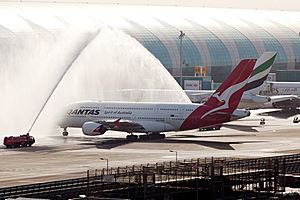
In 2012, Qantas reported a full-year loss of A$245 million for the year ending June 2012. This was due to high fuel prices, strong competition, and worker disputes. This was the first full-year loss since Qantas became fully private in 1995. Because of this, the airline canceled its order for 35 new Boeing 787 planes to save money. Qantas later sold its 50% share of StarTrack, Australia's largest road freight company. It also gained full ownership of Australian airExpress. In March 2012, Qantas set up Jetstar Hong Kong with China Eastern Airlines Corporation. This airline was meant to start flights in 2013 but faced long approval delays.
Qantas and Emirates started a partnership on March 31, 2013. Together, they offered 98 flights per week to Dubai. In September 2013, Qantas expected another loss of A$250 million for the half-year ending December 31. It announced more cost-cutting measures, including cutting 1,000 jobs within a year. S&P lowered Qantas' credit rating. Moody's did the same a month later.
Losses continued into 2014, with the Qantas Group reporting a half-year loss of A$235 million and a full-year loss of A$2.84 billion. In February 2014, Qantas announced plans to save A$2 billion. This included cutting 5,000 jobs, reducing the workforce from 32,000 to 27,000 by 2017. In May 2014, the company said it expected to cut 2,200 jobs by June 2014, including 100 pilots. Qantas also reduced its fleet by retiring planes and delaying new deliveries. It also planned to sell some of its assets.
By June 2014, 2,200 employees had been laid off, and another 1,800 job cuts were planned by June 2015. Also in 2014, the Qantas Sale Act was changed. This act limits foreign ownership of Qantas to 49%. A single foreign company can own no more than 25% of the airline's shares.
Qantas returned to profit in 2015, announcing a profit of A$557 million after tax in August 2015. This was a big change from the A$2.84 billion loss the year before. In 2015, Qantas sold its lease of Terminal 3 at Sydney Airport back to Sydney Airport Corporation for $535 million. This meant Sydney Airport took over running the terminal, including its shops.
Safety Record
People often say that Qantas has never had a plane crash. While it is true that the company has never lost a jet airliner or had any deaths on jet flights, it did have eight fatal accidents and one plane shot down between 1927 and 1945. These accidents resulted in the loss of 63 people. Half of these accidents and the shoot-down happened during World War II, when Qantas planes were flying for Allied military forces. After the war, Qantas lost four more planes (one was owned by BOAC but flown by Qantas) with a total of 21 people killed. The last fatal accidents for Qantas were in 1951, with three crashes in five months. Qantas' safety record has led it to be known as the world's safest airline for many years.
Since the end of World War II, the following accidents and incidents have occurred:
- On March 23, 1946, an Avro Lancastrian plane disappeared over the Indian Ocean. This plane was owned by BOAC but flown by Qantas. It disappeared with seven people on board between Colombo, Ceylon (now Sri Lanka), and the Cocos (Keeling) Islands.
- On April 7, 1949, an Avro Lancastrian plane crashed during a training flight in Dubbo, New South Wales. The plane was destroyed by fire, but the crew got out safely.
- On July 16, 1951, a de Havilland Australia DHA-3 Drover plane crashed off the coast of New Guinea after an engine part failed. The pilot and six passengers died.
- On September 21, 1951, a de Havilland DH.84 Dragon plane crashed in the mountains of New Guinea. No passengers were on board, but the pilot died.
- On December 13, 1951, a de Havilland DH.84 Dragon plane crashed in the mountains near Mount Hagen, New Guinea. The pilot and two passengers died. This was the last fatal accident for Qantas.
- On August 24, 1960, a Lockheed L-1049 Super Constellation plane crashed during takeoff in Mauritius. The takeoff was stopped after an engine failed, and the plane went off the runway and caught fire. No one died.
- On June 1, 1989, Qantas Flight 5, a Boeing 747-200, was flying from Sydney to Singapore. It suddenly climbed and then dropped sharply. Passengers who were not buckled in hit the ceiling. The plane landed in Darwin, and 47 passengers went to the hospital with injuries.
- On September 23, 1999, Qantas Flight 1, a Boeing 747–400, went off the runway while landing at Bangkok, Thailand, during a heavy thunderstorm. The plane stopped on a golf course, but no one died.
- On July 25, 2008, Qantas Flight 30, a Boeing 747–400, had a hole in its side and lost air pressure because an oxygen tank exploded over the South China Sea. The plane was flying from Hong Kong International Airport to Melbourne Airport. It made an emergency landing in the Philippines, and no one was hurt.
- On October 7, 2008, an Airbus A330-300, flying from Singapore Changi Airport to Perth as Qantas Flight 72, suddenly dropped altitude twice. This caused serious injuries to many people. The plane landed safely in Learmonth. Investigations found a problem with a flight control system.
- On November 4, 2010, Qantas Flight 32, an Airbus A380, had an engine failure shortly after taking off from Singapore Changi Airport. The plane was flying to Sydney. It returned to Singapore and landed safely. None of the 440 passengers or 29 crew members were injured.
Extortion Attempts
On May 26, 1971, Qantas received a call from someone named "Mr. Brown." He claimed there was a bomb on a plane going to Hong Kong and demanded $500,000. Police found a real bomb in an airport locker, so they took the threat seriously. Arrangements were made for Mr. Brown to pick up the money. After he collected it, he called again and said the bomb story was a trick. Police later arrested an Englishman named Peter Macari and found some of the money. Macari was sent to prison and later deported.
On July 4, 1997, another similar attempt to get money from Qantas was stopped by police and Qantas security.
See also
 In Spanish: Qantas para niños
In Spanish: Qantas para niños
- The Double Sunrise
- Qantas Founders Outback Museum
- Qantas House
- Qantassaurus, a dinosaur named after the airline
- Southern Cross Route
- Wallaby Route
General:
- List of airlines of Australia
- List of oldest companies in Australia
- Transport in Australia


